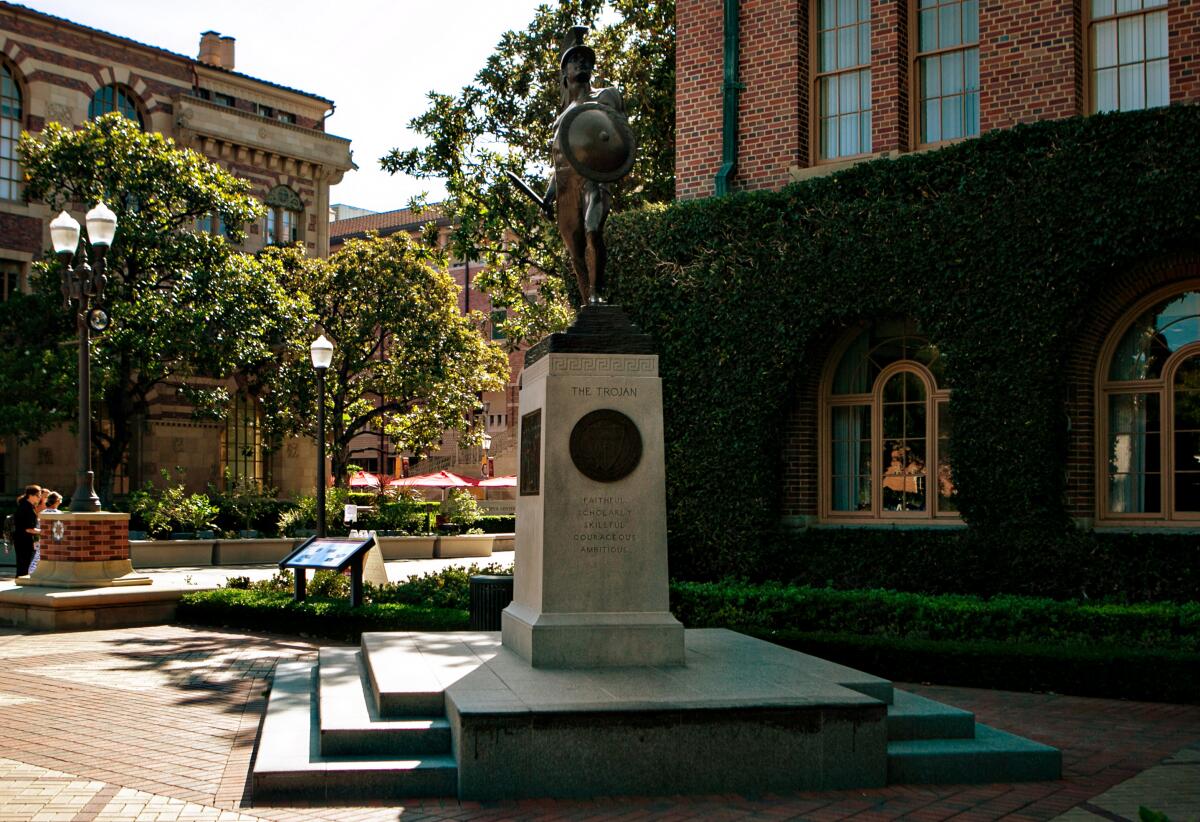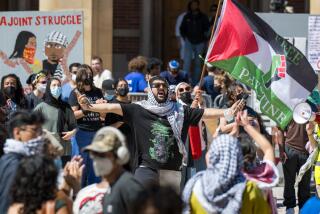USC finds racial profiling with campus security, urges more oversight

- Share via
More than a year after the murder of George Floyd ignited national protests over policing, USC on Wednesday unveiled recommendations to heighten scrutiny of campus safety officers after a broad review found troubling instances of racial profiling and a pervasive sense of “two USCs,” where not everyone was treated with equal fairness and respect.
The report found that 31.7% of 1,050 stops by campus officers in 2019-20 involved Black people, although they made up just 5.5% of students, 8.8% of staff, 3% of faculty and 12% of neighbors in the University Park area. Latinos were also disproportionately stopped in comparison with their presence on campus, the report found.
“When we analyzed the stops data ... we flagged a huge problem,” said Ange-Marie Hancock Alfaro, chair of the USC political science and international relations department, who helped lead the review.
But a demand that has escalated nationwide — defunding police and abolishing their presence on campus — was not on the table. That’s because USC, as a private institution, is not legally authorized to ban police and must adhere to city and state laws requiring law enforcement access to campus, according to Erroll Southers, a longtime USC professor and expert in security and extremism studies who also led the effort.
He said the idea that USC could eliminate law enforcement from campus, as some students and faculty have demanded, was “one of the most challenging pieces of misinformation we had to push back on consistently.”
The 45 recommendations by a diverse community advisory board included formation of an independent oversight board, more robust data collection of officer activities and reassigning some duties they perform, such as responding to calls involving mental health or homelessness, to others. Campus members should be provided with the means, such as QR codes, to report their interactions with officers, and officers should be terminated if they show pervasive patterns of discriminatory behavior, the report recommended.
Southers said the 10-month effort was the most comprehensive review of campus safety practices in the university’s history. It was requested by USC President Carol L. Folt after Floyd’s murder and the national protests over racism in policing practices. The board that led the effort was empowered by Folt to put “everything on the table” and report directly to her as they interviewed more than 700 students, faculty, staff, neighbors and current and former law enforcement members in what they called a “co-design” process, Southers said.
In a letter to the campus community, Folt hailed the “transformative ideas” in the report and expressed excitement about implementing them in an effort to “advance belonging and equity on our campuses.” In the last several months, USC has rolled out a new anti-harassment policy, instituted diversity training for students, hired a chief inclusion and diversity officer and removed the name of Rufus B. von KleinSmid, a eugenics advocate, from a prominent campus building.
The report includes the overarching goal to enhance a sense of “One USC” by creating safety practices that are inclusive and equitable to all campus and community members. Some students, staff and faculty felt safe with officers, while others felt targeted; some community members felt they were treated unfairly compared with campus members, the report found.
“It was a consistent message of: Depending on who you are and where you were, that you weren’t on the same level of equitability,” Southers said.
Alfaro, the board co-chair, said there was a particularly pressing need to gather more extensive data on officer activities and complaints against them. “We don’t have the data that we need to really assess the size and scope of the problem” of unequal treatment, she said.
John Thomas, chief of the USC Department of Public Safety, who served on the board, said he welcomed the recommendations. Thomas, who is Black, said he was racially profiled by police as a young man and wanted to get at the reasons behind the data showing disproportionate treatment, particularly of men of color. The 307-member campus safety force is highly diverse — 50% of officers are Latino, 29% are Black, 11% are white and 3% are Asian — but most of the stops they make are triggered by calls from the community, he said. In the last year, he added, the dispatch center has begun asking more questions about the nature of “suspicious activity” reported before sending officers out.
“After being in this profession for 37 years, I can say that nobody hates a bad cop more than a good cop,” Thomas said. “If we are held accountable ... I would tell you that our officers would welcome that.”
Advisory board members could not reach consensus on whether officers should be issued body cameras, Southers said.
The campus safety force operates under a memorandum of understanding with the city of Los Angeles that gives officers the right to arrest people. About one-third of the force are armed and fully trained police officers.
Thomas said he would welcome redefining the role of campus safety officers — focusing more on crime prevention and pervasive incidents of theft, for instance, and handing off more specialized tasks such as mental health. Because they are the only entity operating on campus 24 hours a day all year, he said, his officers get called for a wide range of duties. About 70% of service calls involve opening locked doors and gates.
He said he was eager to get started on the work, especially since a similar attempt at revising campus safety practices four or five years ago fizzled out.
“The more points of contact to build relationships, provide accountability and transparency ... with the various stakeholders that we’re beholden to, it just makes for a more compassionate department, a more welcoming department,” he said.
Folt said she has assembled a team to review the recommendations and would begin to put them in place in the coming months.
More to Read
Sign up for Essential California
The most important California stories and recommendations in your inbox every morning.
You may occasionally receive promotional content from the Los Angeles Times.











